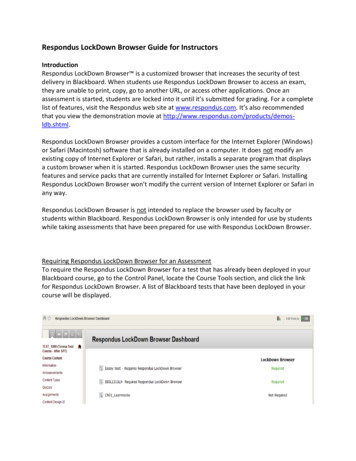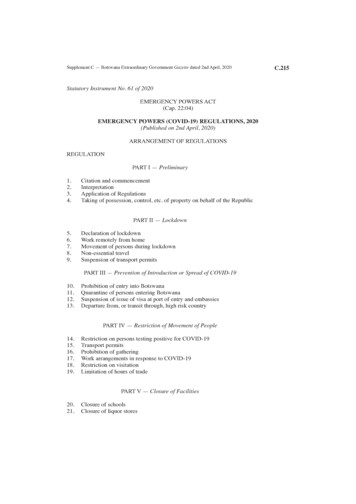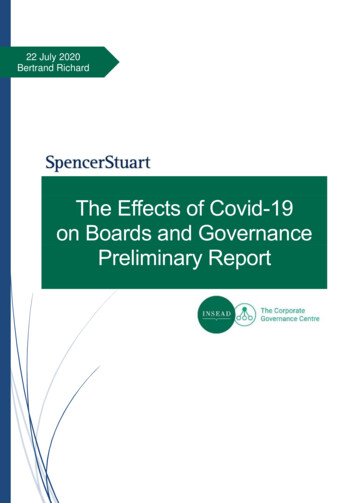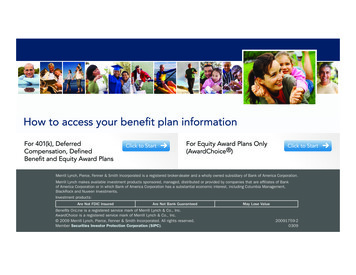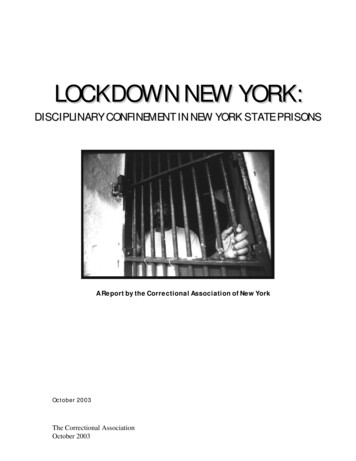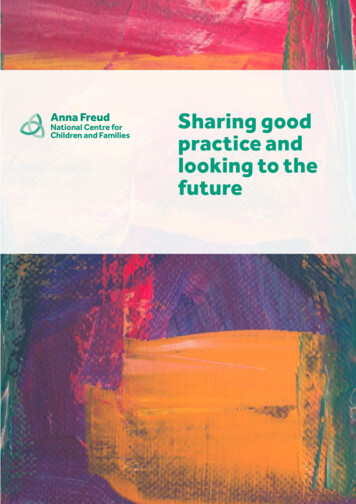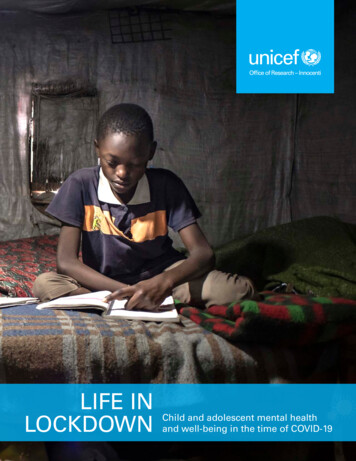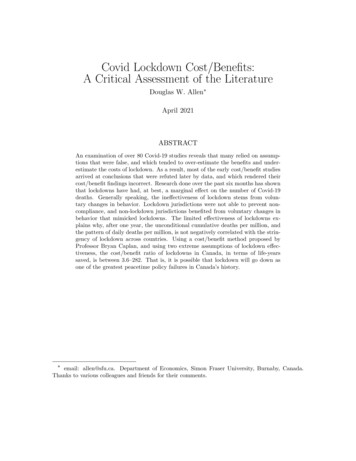
Transcription
Covid Lockdown Cost/Benefits:A Critical Assessment of the LiteratureDouglas W. Allen April 2021ABSTRACTAn examination of over 80 Covid-19 studies reveals that many relied on assumptions that were false, and which tended to over-estimate the benefits and underestimate the costs of lockdown. As a result, most of the early cost/benefit studiesarrived at conclusions that were refuted later by data, and which rendered theircost/benefit findings incorrect. Research done over the past six months has shownthat lockdowns have had, at best, a marginal effect on the number of Covid-19deaths. Generally speaking, the ineffectiveness of lockdown stems from voluntary changes in behavior. Lockdown jurisdictions were not able to prevent noncompliance, and non-lockdown jurisdictions benefited from voluntary changes inbehavior that mimicked lockdowns. The limited effectiveness of lockdowns explains why, after one year, the unconditional cumulative deaths per million, andthe pattern of daily deaths per million, is not negatively correlated with the stringency of lockdown across countries. Using a cost/benefit method proposed byProfessor Bryan Caplan, and using two extreme assumptions of lockdown effectiveness, the cost/benefit ratio of lockdowns in Canada, in terms of life-yearssaved, is between 3.6–282. That is, it is possible that lockdown will go down asone of the greatest peacetime policy failures in Canada’s history. email: allen@sfu.ca. Department of Economics, Simon Fraser University, Burnaby, Canada.Thanks to various colleagues and friends for their comments.
I. IntroductionIn my forty years as an academic, I’ve never seen anything like the responseand reaction to Covid-19. The research response has been immense, with estimatesof over 40,000 papers related to the topic produced in one year. This researchcovers every imaginable aspect of Covid-19, and over the course of the past yearknowledge about the virus, the human reactions to it, and the consequences of thesereactions has exploded. In one word, the Covid-19 information cascade has been“overwhelming.”In contrast, the ubiquitous media, public health, and political response to thepandemic has been one-sided, incomplete, and almost unchanging over the past year.With respect to lockdown policies, many political jurisdictions have repeated thesame spring 2020 programs in 2021, ignoring what has been learned in the meantime.Often public announcements were made that were inconsistent with basic Covid-19facts that were easy to look up if you know where to look. Furthermore, whenresearch results contrary to the official government response were shared on socialmedia, they were often pulled from social media platforms. As a result, for averageCanadians the public media and official public health news conferences have beenthe only source of Covid-19 information.This review of a small segment of the literature is intended to give some guidancefor those who would otherwise not have access to academic research. The focus is toonly critically assess the cost/benefit studies that have been written over the pastyear on lockdown policies related to the Covid-19 pandemic.1The report covers over 80 different academic studies and related Covid-19 datasites. I have sought out studies that i) dealt with matters of “lockdown” eitherdirectly or indirectly, and ii) were related directly or indirectly to issues relevant tothe costs or benefits of lockdown.1 The studies referred to are listed in the Reference section. Many papers and data sites havelinks to webpages. Because these links often “ran off the page” I often had to break them up byinserting a space. Hence, if the link does not work, check to make sure there are no spaces.
The term “lockdown” is used to generically refer to state actions that imposedvarious forms of non-pharmaceutical interventions. That is, the term will be usedto include mandatory state-enforced closing of non-essential business, education,recreation, and spiritual facilities; mask and social distancing orders; stay-in-placeorders; and restrictions on private social gatherings.“Lockdown” does not refer to cases of “isolation,” where a country was able toengage in an early and sufficient border closure that prevented trans-border transmission, followed by a mandated lockdown that eliminated the virus in the domesticpopulation, which was then followed by perpetual isolation until the population isfully vaccinated. This strategy was adopted by a number of island countries likeNew Zealand.2 Here I will only consider lockdown as it took place in Canada andmost of the world; that is, within a country where the virus became established.This is a complicated report because it covers a wide range of studies, and dealswith a wide range of issues. Table 1 outlines the substance of the report. SectionsII: A and B, discuss four critical assumptions often made within the context ofestimating benefits and costs. Understanding these assumptions explains why earlystudies claimed that the benefits of lockdown were so high, and also explains whythe predictions of those models turned out to be false.Section II: C, examines major cost/benefit studies completed over the first sixmonths of the pandemic, and then focuses on what I believe to be the critical factor:distinguishing between mandated and voluntary changes in behavior. This sectionconcludes with an interpretation of some unconditional death comparisons acrosscountries that are typically reported in the media. Section II:D surveys the researchdone on the costs of lockdown. Finally, Section III. presents a simple alternativecost/benefit methodology to generate two cost/benefit ratios of lockdown.2 Other island countries with this strategy include many Pacific island nations (like Samoa andTonga), Caribbean islands (like Cuba and Jamaica), and Iceland. Some countries have been able tomimic being islands in border closings like South Korea, Finland, and Norway.–
Table 1: Outline of the Main Body of ReportII. Cost Benefit StudiesA. Issues in Determining Lockdown BenefitsThe Counterfactual Number of Cases/DeathsThe Exogenous Behavior AssumptionThe Assumed Value of LifeB. An Issue in Lockdown CostsComparing Apples to OrangesSummary of Theoretical IssuesC. Reviewing Lockdown Cost/Benefit StudiesEarly Theoretical Cost/Benefit StudiesApril–June: Early Challenging ResultsFour Stylized Facts About Covid-19Voluntary versus Mandated Lockdown ChannelsUnconditional Cross-Country Covid-19 ComparisonsD. The Costs of LockdownIII. An Alternative Cost/Benefit MethodologyThe major conclusions of this report are:a. A proper cost/benefit study of a specific policy must consider all costs andall benefits of that policy.b. All estimates of costs and benefits depend on various assumptions of parameters and structural model forms, and many of the studies examined(especially the early ones) relied on assumptions that were false, and whichtended to over-estimate the benefits and under-estimate the costs of lockdown.c. As a result of (b) most of the early cost/benefit studies arrived at conclusions that were refuted later by data, and which rendered their cost/benefitfindings incorrect.d. Advances in models and data over the past six months have showed thatlockdowns have had, at best, a marginal effect on the number of Covid-19–
deaths. Generally speaking, the ineffectiveness of lockdown stems from voluntary changes in behavior. Lockdown jurisdictions were not able to preventnon-compliance, and non-lockdown jurisdictions benefited from voluntarychanges in behavior that mimicked lockdowns.e. The limited effectiveness of lockdowns explains why, after one year, theunconditional cumulative deaths per million, and the pattern of daily deathsper million, is not negatively correlated with the stringency of lockdownacross countries.f. Using a cost/benefit method proposed by Professor Bryan Caplan, and usingtwo extreme assumptions of lockdown effectiveness, the cost/benefit ratioof lockdowns in terms of life-years saved is between 3.6–282.II. Cost Benefit StudiesWhen it comes to the question of choosing any type of public policy, the Nobelprize winner Ronald Coase put it best:It would clearly be desirable if the only actions performed were those in whichwhat was gained was worth more than what was lost. But in choosing betweensocial arrangements within the context of which individual decisions are made,we have to bear in mind that a change in the existing system which will lead toan improvement in some decisions may well lead to a worsening of others. Indevising and choosing between social arrangements we should have regard for thetotal effect.[Coase p. 44, 1960]Coase was making two points. The first should be obvious: policy decisionsshould be made based on both costs and benefits. To focus on one side of the issueand consider only costs or only benefits will necessarily provide a misdirection. Thesecond point is more subtle: an attempt to achieve a particular benefit through onemechanism might lead to an exacerbation of the costs. There are multiple methodsto achieve a goal, but the cost consequences might be different for each method.At the end of the day, choosing the optimal policy requires a “regard for the totaleffect.”–
Over the course of the Covid-19 pandemic, there has been no public evidencethat either the federal or provincial governments of Canada have considered boththe benefit and cost sides of their policy decisions. To my knowledge, no governmenthas provided any formal cost/benefit analysis of their actions. Indeed, the steadypress conferences and news releases almost entirely focus on one single feature ofthe disease. Although the focus of government announcements has changed over theyear, from “flattening the curve”, number of Covid-19 deaths, number of Covid19cases, variant transmissions, etc., there has seldom been any mention of the costsof the actions taken to address these concerns.Economists and other social scientists have naturally been attracted to the policy issues surrounding Covid-19. Economists in particular, given their training inmodeling human behavior and testing those models with real world data, have written hundreds of papers that deal with both the costs and the benefits of lockdown.Here, aside from going through some of the theoretical issues, I provide a summaryof the major findings.A. Issues in Determining Lockdown BenefitsOver the course of the first six months of the pandemic most of the “action”in cost/benefit studies came from the benefit side. That is, many studies reportedenormous benefits to lockdown, and so little attention was given to the particularsof lockdown costs. Therefore, before going through a sequential review of studies toshow the progression of understanding over the past year, I start by addressing somegeneral theoretical and empirical issues of estimating Covid-19 lockdown benefits.Understanding these assumptions explains why the conclusions across studies areso different.The Counterfactual Number of Cases/DeathsThe argument for lockdown benefits is intuitive. If a new virus enters a population with no immunity and spreads exponentially, causing an overwhelming of–
hospitals and subsequent large numbers of deaths, then a physical intervention thatisolates people and slows down the transmission of the virus can reduce the spike ofinfections, allow hospitals to cope given their capacity constraints, postpone deaths,and possibly reduce deaths if a vaccine can be created in time. Lockdown is a formal,state-mandated “one size fits all” version of the social norm “keep your distancefrom people who are sick.”If lockdown reduces the transmission of the virus, the natural question to askis “by how much?” In other words, “but for the lockdown” what would the level ofinfection/transmission/deaths be? What is the counterfactual to lockdowns?Within the field of epidemiology it is common to model disease through what iscalled a SIRS model. This is a model that depends on number of people susceptible(S), infectious (I), or recovered (R). These models can vary in many ways, and caninclude many parameters and constraints. Early in the pandemic the Neil Fergusonet al. (March 2020) model (known as the Imperial College of London (ICL) model),appeared to drive many lockdown decisions, and certainly was widely covered inthe media.In these models the virus progresses through a population in a mechanical fashion. There are a number of parameters in the model, including the basic reproduction number, Rt . The basic reproduction number varies over time, and indicatesthe expected number of secondary infections in a vulnerable population that aregenerated by a single given infection. Lockdowns are often interpreted as a meansof effectively altering the reproduction number.Figure 1 reproduces a key figure of the Ferguson et al. paper, and shows theresults of various types of lockdown on occupied ICU beds. The symmetry, smoothness, and orderly appearance of the functions is a result of the mechanical natureof the model. This type of figure is found, in one form or another, in most papersbased on a SIRS model.–
Figure 1: ICU Predictions in ICL ModelWe can use Figure 1 to see the implications of the SIRS model for determiningthe counterfactual. Suppose, for the sake of argument that the blue line lockdownwas enacted. Then, reading from the graph, on June 20th approximately 80 ICUbeds would have been occupied. However, the counterfactual would be taken fromthe black “do nothing” line, and reading from the graph there would have been 200ICU beds occupied. The blue lockdown would have reduced the number of ICU bedsoccupied by 120. Because SIRS models have an exponential growth characteristicuntil a population approaches herd immunity, the “do nothing” counterfactual canbe enormous, and this automatically makes lockdown look better.As a result, the ICL model made some dire predictions that saturated mediacoverage in the first wave of the pandemic. For instance: “In the (unlikely) absenceof any control measures or spontaneous changes in individual behaviour . In total,in an unmitigated epidemic, we would predict approximately 510,000 deaths in GBand 2.2 million in the US, not accounting for the potential negative effects of healthsystems being overwhelmed on mortality.” (p. 7, 2020).The authors also made a dramatic recommendation: “We therefore concludethat epidemic suppression is the only viable strategy at the current time. Thesocial and economic effects of the measures which are needed to achieve this policygoal will be profound.” (Ferguson et al. p. 16, 2020).–
In retrospect it is remarkable that such a conclusion was drawn. The authorsrecognized that the “social and economic effects” would be “profound,” and that thepredictions were based on the “unlikely” behavioral assumption that there would beno change to individual reactions to a virus. However, given the large counterfactualnumbers, presumably they felt no reasonable cost could justify not locking down.3Problems with the ICL model were pointed out almost immediately. Theseproblems included: i) the reproduction number (Rt ) of 2.4 was too high; ii) theassumed infection fatality rate (IFR) of 0.9% was too high and not age dependent;iii) hospital capacity was assumed fixed and unchangeable; and iv) individuals in themodel were assumed to not change behavior in the face of a new virus.4 However,the point to stress is that all of these assumptions have the effect of over-estimatingthe counterfactual number of cases, transmissions, and deaths.5The Exogenous Behavior AssumptionAs mentioned, a critical parameter in a SIRS model is the basic reproductionnumber, Rt . A typical SIRS model shows that cases of the virus explode exponentially when the Rt 1, and then collapse as herd immunity is reached and thevirus recedes to an endemic state. This pattern was shown in Figure 1, and thisparticular evolution of the virus happens because no individual in the model everchanges behavior.3 To appreciate how far off the Ferguson et al. model predictions were, consider that the predictednumber of deaths in the U.K. and the U.S. was to happen by July of 2020. Both the U.S. andU.K. have had relatively high death rates due to Covid-19, but as of March 12, 2021 the U.S. hasexperienced 536,914 deaths and the U.K. 125,927 deaths (OurWorldInData). The ICL model wasoff by a factor of four, over twice the time period.4 Estimates of the IFR have continued to fall over the year. The latest meta-study by Ioannidis(March 2021) estimates the average global IFR at 0.15%.5 There are many forms of SIRs models, and the exact channel by which the virus mechanicallyprogresses varies across studies. For example, Ambikapathy and Krishnamurthy (April 2020) modelthe exponential viral growth using a system of differential equations that mimic a SIRS model.Given the assumed parameters in the model, lockdowns inhibit the transmission rates and producea predicted benefit. See also Sjódin et al. April 2020, or Liu et al. May 2020 for other examples ofmechanical virus models.–
The implication of ignoring individual responses to a viral threat are dramatic.Atkeson (February 2021) uses a standard SIRS model (with exogenous behavior)that included seasonal effects and the introduction of a more contagious variant inDecember 2020 to forecast daily U.S. deaths out to July 2023. The results of thisstandard model are shown in panel (a) of Figure 2 by the blue line; the red line inpanel (a) shows the actual daily deaths. The vertical axis is raised to the 104 power,so daily deaths are predicted to have peaked at 30,000 in July of 2020. Comparedto the red line in panel (a), the standard model over estimated the peak number ofdeaths by a factor of about 12.(a)(b)Figure 2: Predicted and Actual Daily U.S. DeathsAtkeson (February 2021) then used the same model with a simple behavioraladjustment that allowed individuals to change behavior in light of the value of Rt .The new forecast of daily deaths is shown as the blue line in panel (b) of Figure 2.Adding the single behavioral response completely changed the model’s predictivepower. The model now tracks the actual progression of the daily deaths very closely.In correspondence with Atkeson he provided the reason for this result:The intuition for this result is simple. If new infections and daily deaths from thedisease grow too high, people take costly efforts to avoid interaction and thus slowdisease spread. Likewise, if the prevalence of the disease falls toward zero, thenthe demand for costly disease prevention efforts also falls towards zero, and so the–
disease will come back unless the population has already achieved herd immunitymeasured at pre-pandemic levels of behavior.Whether Atkeson (February 2021) has correctly modeled the Covid-19 virus isnot at issue. The point is, there is a dramatic change in predicted behavior oncehuman reactions are included. A model lacking endogenous individual adjustmentradically mis-estimates the number of daily deaths, and this is a common problemin many cost/benefit studies.The fact that individuals privately and voluntarily respond to risks has twoimportant implications.6 First, it influences how any counterfactual outcome is understood with respect to the lockdown. When no voluntary response is assumed,models predict the case load and deaths explode exponentially without lockdowns.If lockdowns are imposed and cases coincidently fall, the actual number of cases isthen compared to a counterfactual that never would have happened.7 Therefore, notaccounting for rational, voluntary individual responses within a SIRS model drastically overstates any benefit from lockdown.8 When considering various cost/benefit6 The notion that epidemiological models need to contain endogenous human behavior was ex-plained in a classic paper by Philipson (2000).7 An example of this is found in Hsiang et al. (August 2020), who use the pre-lockdown growthrates of the virus in their calculation of the counterfactual trajectory of new cases. This ignores thefact that transmission and infection rates vary over time, and that a major reason for this variationis voluntary changes in behavior.8 Looking back on statements made in March/April 2020 by medical professionals and epidemiolo-gist shows how far off their predictions were. Michael Osterholm, director of the Center for InfectiousDisease Research and Policy at the University of Minnesota, stated on The Joe Rogan Experiencein March 2020 that “We conservatively estimate that this could require 48 million hospitalizations, 96 million cases actually occurring, over 480,000 deaths that can occur over the next four toseven months with this situation.” (Quoted from ospitalizations-132167). The reality was thatas of July 16, 2020 there were 138,000 deaths, 250,000 hospitalizations, and 3,600,000 confirmedcases. Unabashed, Osterholm stated on February 2, 2021 that the new variant would cause a ‘hurricane’ of new cases, and “The fact is that the surge that is likely to occur with this new variant fromEngland is going to happen in the next six to fourteen weeks. And, if we see that happen, which myforty-five years in the trenches tell me we will, we are going to see something like we have not seenyet in this country .”. Quoted from 177476. According to OurWorldInData, on February 2,–
studies it is important to discount models that assume no individual response to aviral threat.Second, any empirical work that considers only the total change in outcomes anddoes not attempt to separate the mandated effect from the voluntary effect, willnecessarily attribute all of the change in outcome to the mandated lockdown. Onceagain, this will over-estimate the effect, and quite likely by an order of magnitude.Individuals change behavior for two reasons. They voluntarily respond to thethreat of a virus, and they react to mandated lockdowns. Both effects create atotal change in behavior that is the result of these two channels. It is extremelyimportant that the empirical work done on lockdown effects distinguish betweenthe two channels of behavior to determine how much behavior changed because ofmandated lockdowns and how much because of voluntary changes.9The Assumed Value of LifeAll economic cost/benefit studies of Covid-19, either directly or indirectly, utilizesome method to estimate the number of cases, infections, or deaths as the virusprogresses through the population over time. Counting cases and deaths, however,2021 there were 428 cases per million people in the U.S. As of March 14, six weeks later, there were163 cases per million. Cases did not rise to unprecedented hurricane levels, but rather fell by morethan two times.9 For example, if only 10% of change in cases is caused by mandated lockdown and 90% is causedby voluntary changes in behavior, then attributing all of the effect to lockdown over-estimates thelockdown effect by nine times. The less important mandated lockdowns are, the greater the overestimation. This issue was publicly known as early as April 2020. Abouk (April 2020) examineddifferences in policies across the U.S. and separated out the voluntary effect. He noted (p. 2):While there is strong evidence for reduced social contact in the US, not all ofthese reductions can be attributed to NPIs: mobility data show that people inmost states had already started to reduce the time they spend outside their homesbefore any NPI was implemented.He found that stay-at-home orders had a substantial effect on confirmed cases, but business andschool closures, along with bans of large gatherings did not.–
is only half the process. To estimate benefits and compare them to costs economistsassign a dollar value to the change in outcomes. If lockdown benefits are in termsof the number of deaths delayed, then a value to these lives must be used.10In economics, the concept of “value” is based on the idea of maximum sacrifice. How much one is willing to sacrifice, at most, for something determines thatindividual’s economic value of the thing. Thus, when it comes to the value of anindividual’s life, this value is determined by the actual individual. In practice, whatis measured is how much individuals are willing to sacrifice to extend their life alittle bit by reducing some type of harm (called a ‘marginal’ value), and then usethis to determine a total value of life.Everyday people make decisions that directly and indirectly are based on theirmarginal value of life. The decisions to eat poor foods, smoke, accept dangerousemployment, cross a street, drive a car, exercise, or engage with others all entailrisks to life and therefore imply a value of life. Economists and policy makers ingeneral use the notion of an individual’s marginal value of life in determining whatit is called “The Value of a Statistical Life” (VSL). The VSL concept was developedin the 1960s by Thomas Schelling, and is widely used in policy work.The VSL is estimated by observing individual marginal tradeoffs. Thus, if weobserved someone willing to pay 1000 to reduce the chance of death by 1/10,000over the next year, then this would imply a value of life of 10,000,000 (10, 000 1000).One problem with using the VSL for estimating the benefits of saving livesthrough lockdown is that it measures the total value of life based on a marginalvalue. Thus, using a VSL (which is based on observing ordinary people not at thepoint of death) as a measure of the value of a life of someone about to die, is likelyto provide an over-estimate of the value of the life.10 Many object to the assignment of a number to the value of a life. To do so, however, makes itimpossible to compare the costs and benefits of a policy decision. I abstract from this philosophicaland moral issue.–
In many Covid-19 cost/benefit studies, however, there is another more seriousproblem with how the VSL is used. Namely, it is often assumed that i) the VSL isindependent of age, and ii) that the VSL is equal to around 10,000,000. Both ofthese claims are not true.11Hammitt (pp. 10–12) surveys the literature on VSL estimates and shows thatall studies reject the idea that the VSL is constant over the life-cycle. For example,one age based VSL estimate from Robinson, et al. (July 2020) is shown in Figure2.VSL Adjusted by Life Expectancy(millions of dollars) 16.00 14.00 12.00 10.00 8.00 6.00 4.00 2.00 0.00Under 1–41 year years5–14 15–24 25–34 35–44 45–54 55–64 65–74 75–84 85years years years years years years years years yearsandoverFigure 3: Age Related Estimates of VSLTo assume that the VSL is constant implies that individuals are indifferentbetween living one more day or eighty more years. Figure 3 shows more reasonableestimates, with the value of a child being seven times the value of an 85 year old.The VSL of 2,000,000 for an 85 year old is based on the assumption that lifeexpectancy is still ten years. For someone who is 85, in poor health with multipleserious illnesses, the VSL would be much lower.1211 See Hammitt (June, 2020) for an excellent discussion of the VLS and descriptions of how itvaries with age.12 It has been understood for some time that those dying of Covid-19 have comorbidities. Accord-ing to the March 17, 2021 CDC weekly update (https://www.cdc.gov/nchs/nvss/vsrr/covid weekly/–
Assuming a VSL of 10,000,000 creates a strong bias in the conclusion of manyearly cost/benefit studies. Since those over age sixty make up a minority of thepopulation, but account for the vast majority of Covid-19 deaths, the use of aconstant and large VSL leads to a vast over-estimate of the benefits of lockdown.To take the extreme case, if the ICL model estimate implies that 200,000 Canadianswould die from Covid-19 without lockdown, and each life lost was worth 10,000,000,then the benefit of lockdown would be 1 trillion dollars. In 2018 Canada’s GDPwas just 2.1 trillion dollars. At this estimate of death and VSL, it would makesense to shut down (not just lockdown) 50% of the Canadian economy for an entireyear.B. An Issue With Lockdown CostsComparing Apples to OrangesOne final theoretical issue needs to be dealt with before examining variouscost/benefit studies. As noted, when considering the value of lockdown the VSLis used to determine the value of lives saved. The VSL is based on preferences,as it should be, and so the VSL is a dollar measure of the utility an individualreceives from living. Most notably, the VSL is not a measure of how productive anindividual is in terms of the dollar value of goods and services they produce. Aninfant is valuable, as is a retired senior citizen, but neither produces any marketedgoods and services.It is very common, in cost/benefit studies to simply use lost GDP as the measurefor the cost of lockdown. That is, the reduction in the value of goods and servicesproduced was attributed as the only cost of the lockdown. For example, Figure4 shows Canada’s GDP up to November 2020.13 The estimated fall in GDP overindex.htm#ExcessDeaths) only 6% of Covid-19 deaths in the U.S. were attributed to Covid-19 alone.The average number of comorbidities of those who died was 3.8. Thus, even assigning a VSL of 2,000,000 for individuals with multiple comorbidities is too high.13 Taken from Stats Canada: 0129/cg-a001-eng.htm.–
the year is 5.1%, making it the worst year for economic growth since the greatdepression.If 100% of the fall in GDP (approximately 107 billion) is attributed to thelockdown (that is, the virus directly had no effect on production), then comparedto the trillion dollar savings in lives, the costs of lockdown are at most 10% of thevalue of the lives saved, and lockdown s
f. Using a cost/bene t method proposed by Professor Bryan Caplan, and using two extreme assumptions of lockdown e ectiveness, the cost/bene t ratio of lockdowns in terms of life-years saved is between 3.6{282. II. Cost Bene t Studies When it comes to the question of choosing any type of public policy, the Nobel prize winner Ronald Coase put it .
